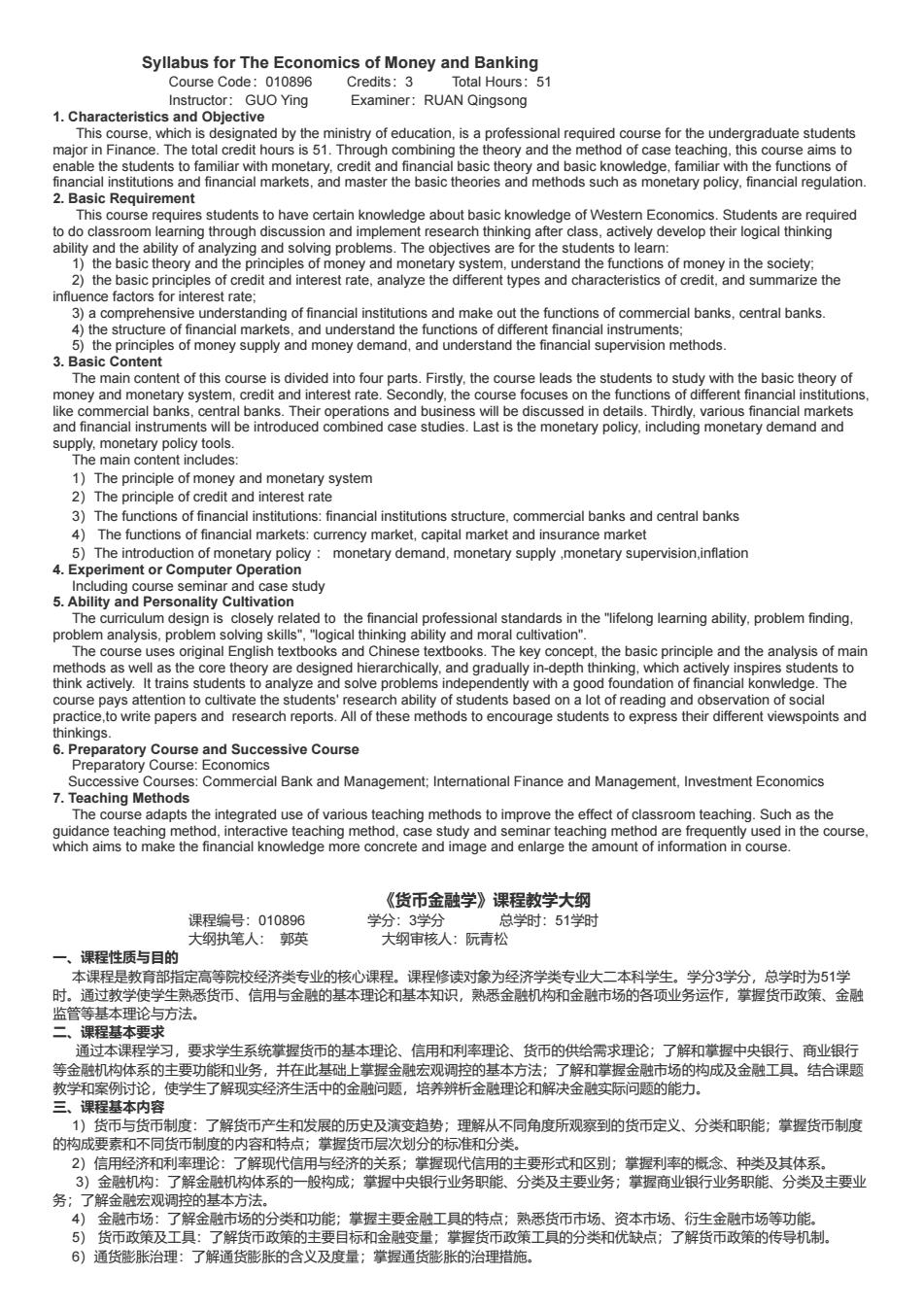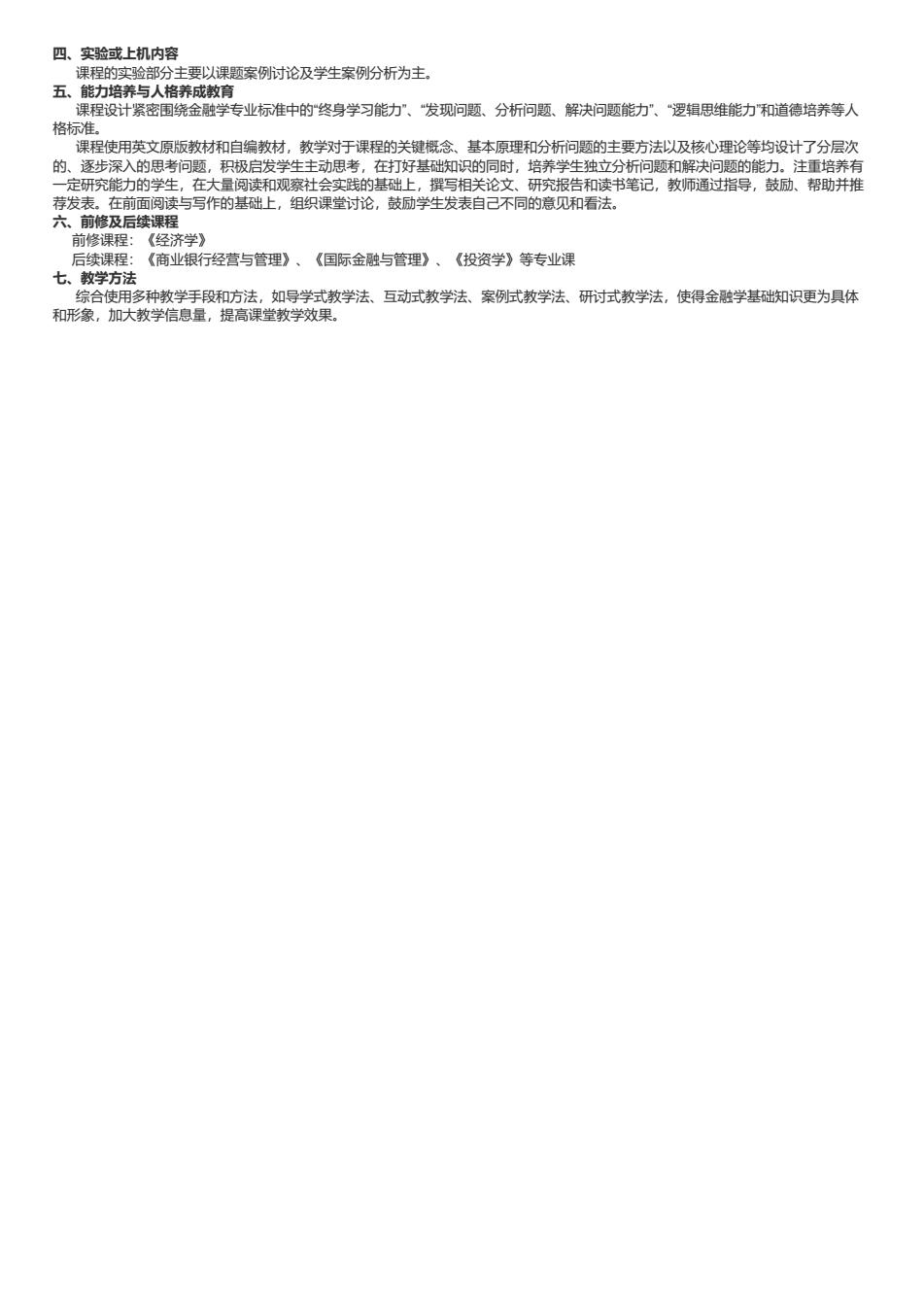
Syllabus for The Economics of Money and Banking Course Code:010896 Credits:3 Total Hours:51 Instructor:GUO Ying Examiner:RUAN Qingsong 1.Characteristics and Objective This course,which is designated by the ministry of education,is a professional required course for the undergraduate students major in Finance.The total credit hours is 51.Through combining the theory and the method of case teaching,this course aims to enable the students to familiar with monetary,credit and financial basic theory and basic knowledge,familiar with the functions of financial institutions and financial markets,and master the basic theories and methods such as monetary policy,financial regulation 2.Basic Requirement This course requires students to have certain knowledge about basic knowledge of Western Economics.Students are required to do classroom learning through discussion and implement research thinking after class,actively develop their logical thinking ability and the ability of analyzing and solving problems.The objectives are for the students to learn 1)the basic theory and the principles of money and monetary system,understand the functions of money in the society: 2)the basic principles of credit and interest rate,analyze the different types and characteristics of credit,and summarize the influence factors for interest rate; 3)a comprehensive understanding of financial institutions and make out the functions of commercial banks,central banks 4)the structure of financial markets,and understand the functions of different financial instruments; 5)the principles of money supply and money demand,and understand the financial supervision methods 3.Basic Content The main content of this course is divided into four parts.Firstly,the course leads the students to study with the basic theory of money and monetary system,credit and interest rate.Secondly,the course focuses on the functions of different financial institutions like commercial banks,central banks.Their operations and business will be discussed in details.Thirdly,various financial markets and financial instruments will be introduced combined case studies.Last is the monetary policy,including monetary demand and supply,monetary policy tools The main content includes: 1) The principle of money and monetary system 2)The principle of credit and interest rate 3)The functions of financial institutions:financial institutions structure,commercial banks and central banks 4)The functions of financial markets:currency market,capital market and insurance market 5)The introduction of monetary policy monetary demand,monetary supply monetary supervision,inflation 4.Experiment or Computer Operation Including course seminar and case study 5.Ability and Personality Cultivation The curriculum design is closely related to the financial professional standards in the "lifelong leaming ability,problem finding. problem analysis,problem solving skills","logical thinking ability and moral cultivation". The course uses original English textbooks and Chinese textbooks.The key concept,the basic principle and the analysis of main methods as well as the core theory are designed hierarchically,and gradually in-depth thinking,which actively inspires students to think actively.It trains students to analyze and solve problems independently with a good foundation of financial konwledge.The course pays attention to cultivate the students'research ability of students based on a lot of reading and observation of social practice,to write papers and research reports.All of these methods to encourage students to express their different viewspoints and thinkings 6.Preparatory Course and Successive Course Preparatory Course:Economics Successive Courses:Commercial Bank and Management;International Finance and Management,Investment Economics 7.Teaching Methods The course adapts the integrated use of various teaching methods to improve the effect of classroom teaching.Such as the guidance teaching method.interactive teaching method,case study and seminar teaching method are frequently used in the course which aims to make the financial knowledge more concrete and image and enlarge the amount of information in course. 《货币金融学》课程教学大纲 课程编号:010896 学分:3学分 总学时:51学时 大纲执笔人:郭英 大纲审核人:阮青松 一、课程性质与目的 本课程是教育部指定高等院校经济类专业的核心课程。课程修读对象为经济学类专业大二本科学生。学分3学分,总学时为51学 时。通过教学使学生熟悉货币、信用与金融的基本理论和基本知识,熟悉金融机构和金融市场的各项业务运作,掌握货币政策、金融 监管等基本理论与方法。 二、课程基本要求 通过本课程学习,要求学生系统掌握货币的基本理论、信用和利率理论、货币的供给需求理论;了解和掌握中央银行、商业银行 等金融机构体系的主要功能和业务,并在此基础上掌握金融宏观调控的基本方法;了解和掌握金融市场的构成及金融工具。结合课题 教学和案例讨论,使学生了解现实经济生活中的金融问题,培养辨析金融理论和解决金融实际问题的能力。 三、课程基本内容 1)货币与货币制度:了解货币产生和发展的历史及演变趋势;理解从不同角度所观察到的货币定义、分类和职能;掌握货币制度 的构成要素和不同货币制度的内容和特点:掌握货币层次划分的标准和分类。 2)信用经济和利率理论:了解现代信用与经济的关系;掌握现代信用的主要形式和区别;掌握利率的概念、种类及其体系, 3)金融机构:了解金融机构体系的一般构成:掌握中央银行业务职能、分类及主要业务;掌握商业银行业务职能、分类及主要业 务:了解金融宏观调控的基本方法。 4)金融市场:了解金融市场的分类和功能;掌握主要金融工具的特点;熟悉货币市场、资本市场、衍生金融市场等功能。 5)货币政策及工具:了解货币政策的主要目标和金变量;掌握货币政策工具的分类和优缺点;了解货币政策的传导机制。 6)通货膨胀治理:了解通货膨胀的含义及度量;掌握通货膨胀的治理措施
Syllabus for The Economics of Money and Banking Course Code:010896 Credits:3 Total Hours:51 Instructor: GUO Ying Examiner:RUAN Qingsong 1. Characteristics and Objective This course, which is designated by the ministry of education, is a professional required course for the undergraduate students major in Finance. The total credit hours is 51. Through combining the theory and the method of case teaching, this course aims to enable the students to familiar with monetary, credit and financial basic theory and basic knowledge, familiar with the functions of financial institutions and financial markets, and master the basic theories and methods such as monetary policy, financial regulation. 2. Basic Requirement This course requires students to have certain knowledge about basic knowledge of Western Economics. Students are required to do classroom learning through discussion and implement research thinking after class, actively develop their logical thinking ability and the ability of analyzing and solving problems. The objectives are for the students to learn: 1) the basic theory and the principles of money and monetary system, understand the functions of money in the society; 2) the basic principles of credit and interest rate, analyze the different types and characteristics of credit, and summarize the influence factors for interest rate; 3) a comprehensive understanding of financial institutions and make out the functions of commercial banks, central banks. 4) the structure of financial markets, and understand the functions of different financial instruments; 5) the principles of money supply and money demand, and understand the financial supervision methods. 3. Basic Content The main content of this course is divided into four parts. Firstly, the course leads the students to study with the basic theory of money and monetary system, credit and interest rate. Secondly, the course focuses on the functions of different financial institutions, like commercial banks, central banks. Their operations and business will be discussed in details. Thirdly, various financial markets and financial instruments will be introduced combined case studies. Last is the monetary policy, including monetary demand and supply, monetary policy tools. The main content includes: 1)The principle of money and monetary system 2)The principle of credit and interest rate 3)The functions of financial institutions: financial institutions structure, commercial banks and central banks 4) The functions of financial markets: currency market, capital market and insurance market 5)The introduction of monetary policy : monetary demand, monetary supply ,monetary supervision,inflation 4. Experiment or Computer Operation Including course seminar and case study 5. Ability and Personality Cultivation The curriculum design is closely related to the financial professional standards in the "lifelong learning ability, problem finding, problem analysis, problem solving skills", "logical thinking ability and moral cultivation". The course uses original English textbooks and Chinese textbooks. The key concept, the basic principle and the analysis of main methods as well as the core theory are designed hierarchically, and gradually in-depth thinking, which actively inspires students to think actively. It trains students to analyze and solve problems independently with a good foundation of financial konwledge. The course pays attention to cultivate the students' research ability of students based on a lot of reading and observation of social practice,to write papers and research reports. All of these methods to encourage students to express their different viewspoints and thinkings. 6. Preparatory Course and Successive Course Preparatory Course: Economics Successive Courses: Commercial Bank and Management; International Finance and Management, Investment Economics 7. Teaching Methods The course adapts the integrated use of various teaching methods to improve the effect of classroom teaching. Such as the guidance teaching method, interactive teaching method, case study and seminar teaching method are frequently used in the course, which aims to make the financial knowledge more concrete and image and enlarge the amount of information in course. 《货币金融学》课程教学大纲 课程编号:010896 学分:3学分 总学时:51学时 大纲执笔人: 郭英 大纲审核人:阮青松 一、课程性质与目的 本课程是教育部指定高等院校经济类专业的核心课程。课程修读对象为经济学类专业大二本科学生。学分3学分,总学时为51学 时。通过教学使学生熟悉货币、信用与金融的基本理论和基本知识,熟悉金融机构和金融市场的各项业务运作,掌握货币政策、金融 监管等基本理论与方法。 二、课程基本要求 通过本课程学习,要求学生系统掌握货币的基本理论、信用和利率理论、货币的供给需求理论;了解和掌握中央银行、商业银行 等金融机构体系的主要功能和业务,并在此基础上掌握金融宏观调控的基本方法;了解和掌握金融市场的构成及金融工具。结合课题 教学和案例讨论,使学生了解现实经济生活中的金融问题,培养辨析金融理论和解决金融实际问题的能力。 三、课程基本内容 1)货币与货币制度:了解货币产生和发展的历史及演变趋势;理解从不同角度所观察到的货币定义、分类和职能;掌握货币制度 的构成要素和不同货币制度的内容和特点;掌握货币层次划分的标准和分类。 2)信用经济和利率理论:了解现代信用与经济的关系;掌握现代信用的主要形式和区别;掌握利率的概念、种类及其体系。 3)金融机构:了解金融机构体系的一般构成;掌握中央银行业务职能、分类及主要业务;掌握商业银行业务职能、分类及主要业 务;了解金融宏观调控的基本方法。 4) 金融市场:了解金融市场的分类和功能;掌握主要金融工具的特点;熟悉货币市场、资本市场、衍生金融市场等功能。 5) 货币政策及工具:了解货币政策的主要目标和金融变量;掌握货币政策工具的分类和优缺点;了解货币政策的传导机制。 6)通货膨胀治理:了解通货膨胀的含义及度量;掌握通货膨胀的治理措施

四、实验或上机内容 课程的实验部分主要以课题案例时论及学生案例分析为主。 五、能力培养与人格养成教育 课程设计紧密围绕金融学专业标准中的“终身学习能力”、“发现问题、分析问题、解决问题能力”、“逻辑思维能力和道德培养等人 格标准。 课程使用英文原版教材和自编教材,教学对于课程的关键概念、基本原理和分析问题的主要方法以及核心理论等均设计了分层次 的、逐步深入的思考问题,积极启发学生主动思考,在打好基础知识的同时,培养学生独立分析问题和解决问题的能力。注重培养有 一定研究能力的学生,在大量阅读和观察社会实践的基础上,撰写相关论文、研究报告和读书笔记,教师通过指导,鼓励、帮助并推 荐发表。在前面阅读与写作的基础上,组织课堂讨论,鼓励学生发表自己不同的意见和看法。 六、前修及后续课程 前修课程:《经济学》 后续课程:《商业银行经营与管理》、《国际金融与管理》、《投资学》等专业课 七、教学方法 综合使用多种教学手段和方法,如导学式教学法、互动式教学法、案例式教学法、研讨式教学法,使得金融学基础知识更为具体 和形象,加大教学信息量,提高课堂教学效果
四、实验或上机内容 课程的实验部分主要以课题案例讨论及学生案例分析为主。 五、能力培养与人格养成教育 课程设计紧密围绕金融学专业标准中的“终身学习能力”、“发现问题、分析问题、解决问题能力”、“逻辑思维能力”和道德培养等人 格标准。 课程使用英文原版教材和自编教材,教学对于课程的关键概念、基本原理和分析问题的主要方法以及核心理论等均设计了分层次 的、逐步深入的思考问题,积极启发学生主动思考,在打好基础知识的同时,培养学生独立分析问题和解决问题的能力。注重培养有 一定研究能力的学生,在大量阅读和观察社会实践的基础上,撰写相关论文、研究报告和读书笔记,教师通过指导,鼓励、帮助并推 荐发表。在前面阅读与写作的基础上,组织课堂讨论,鼓励学生发表自己不同的意见和看法。 六、前修及后续课程 前修课程:《经济学》 后续课程:《商业银行经营与管理》、《国际金融与管理》、《投资学》等专业课 七、教学方法 综合使用多种教学手段和方法,如导学式教学法、互动式教学法、案例式教学法、研讨式教学法,使得金融学基础知识更为具体 和形象,加大教学信息量,提高课堂教学效果